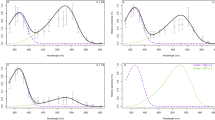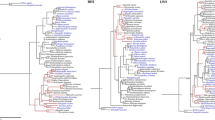Abstract
Among terrestrial animals, only vertebrates and arthropods possess wavelength-discrimination ability, so-called “color vision”. For color vision to exist, multiple opsins which encode visual pigments sensitive to different wavelengths of light are required. While the molecular evolution of opsins in vertebrates has been well investigated, that in arthropods remains to be elucidated. This is mainly due to poor information about the opsin genes of non-insect arthropods. To obtain an overview of the evolution of color vision in Arthropoda, we isolated three kinds of opsins, Rh1, Rh2, and Rh3, from two jumping spider species, Hasarius adansoni and Plexippus paykulli. These spiders belong to Chelicerata, one of the most distant groups from Hexapoda (insects), and have color vision as do insects. Phylogenetic analyses of jumping spider opsins revealed a birth and death process of color vision evolution in the arthropod lineage. Phylogenetic positions of jumping spider opsins revealed that at least three opsins had already existed before the Chelicerata-Pancrustacea split. In addition, sequence comparison between jumping spider Rh3 and the shorter wavelength-sensitive opsins of insects predicted that an opsin of the ancestral arthropod had the lysine residue responsible for UV sensitivity. These results strongly suggest that the ancestral arthropod had at least trichromatic vision with a UV pigment and two visible pigments. Thereafter, in each pancrustacean and chelicerate lineage, the opsin repertoire was reconstructed by gene losses, gene duplications, and function-altering amino acid substitutions, leading to evolution of color vision.




Similar content being viewed by others
References
Berner RA, Canfield DE (1989) A new model for atmospheric oxygen over Phanerozoic time. Am J Sci 289:333–361
Blest AD, Hardie RC, McIntyre P, Williams DS (1981) The spectral sensitivities of identified receptors and the function of retinal tiering in the principle eyes of a jumping spider. J Comp Physiol [A] 145:227–239
Briscoe AD (2000) Six opsins from the butterfly Papilio glaucus: molecular phylogenetic evidence for paralogous origins of red-sensitive visual pigments in insects. J Mol Evol 51:110–121
Briscoe AD, Chittka L (2001) The evolution of color vision in insects. Annu Rev Entomol 46:471–510
Collin SP, Knight MA, Davies WL, Potter IC, Hunt DM, Trezise AE (2003) Ancient colour vision: multiple opsin genes in the ancestral vertebrates. Curr Biol 13:R864–865
Felsenstein J (1981) Evolutionary trees from DNA sequences: a maximum likelihood approach. J Mol Evol 17:368–376
Giribet G, Edgecombe GD, Wheeler WC (2001) Arthropod phylogeny based on eight molecular loci and morphology. Nature 413:157–161
Guindon S, Gascuel O (2003) A simple, fast, and accurate algorithm to estimate large phylogenies by maximum likelihood. Syst Biol 52:696–704
Hisatomi O, Iwasa T, Tokunaga F, Yasui A (1991) Isolation and characterization of lamprey rhodopsin cDNA. Biochem Biophys Res Commun 174:1125–1132
Hwang UW, Friedrich M, Tautz D, Park CJ, Kim W (2001) Mitochondrial protein phylogeny joins myriapods with chelicerates. Nature 413:154–157
Jones DT, Taylor WR, Thornton JM (1992) The rapid generation of mutation data matrices from protein sequences. Comput Appl Biosci 8:275–282
Kasting JF (1987) Theoretical constraints on oxygen and carbon dioxide concentrations in the Precambrian atmosphere. Precambr Res 34:205–229
Katoh K, Kuma K, Miyata T (2001) Genetic algorithm-based maximum-likelihood analysis for molecular phylogeny. J Mol Evol 53:477–484
Katoh K, Misawa K, Kuma K, Miyata T (2002) MAFFT: a novel method for rapid multiple sequence alignment based on fast Fourier transform. Nucleic Acids Res 30:3059–3066
Kishino H, Miyata T, Hasegawa M (1990) Maximum likelihood inference of protein phylogeny and the origin of chloroplasts. J Mol Evol 30:151–161
Koyanagi M, Ono K, Suga H, Iwabe N, Miyata T (1998) Phospholipase C cDNAs from sponge and hydra: antiquity of genes involved in the inositol phospholipid signaling pathway. FEBS Lett 439:66–70
Koyanagi M, Kawano E, Kinugawa Y, Oishi T, Shichida Y, Tamotsu S, Terakita A (2004) Bistable UV pigment in the lamprey pineal. Proc Natl Acad Sci USA 101:6687–6691
Koyanagi M, Kubokawa K, Tsukamoto H, Shichida Y, Terakita A (2005) Cephalochordate melanopsin: evolutionary linkage between invertebrate visual cells and vertebrate photosensitive retinal ganglion cells. Curr Biol 15:1065–1069
Land MF (1969) Structure of the retinae of the principal eyes of jumping spiders (Salticidae: dendryphantinae) in relation to visual optics. J Exp Biol 51:443–470
Land MF, Nilsson D-E (2002) Animal eyes. Oxford University Press, New York
Mallatt JM, Garey JR, Shultz JW (2004) Ecdysozoan phylogeny and Bayesian inference: first use of nearly complete 28S and 18S rRNA gene sequences to classify the arthropods and their kin. Mol Phylogenet Evol 31:178–191
Nakamura T, Yamashita S (2000) Learning and discrimination of colored papers in jumping spiders (Araneae, Salticidae). J Comp Physiol [A] 186:897–901
Nordstrom K, Larsson TA, Larhammar D (2004) Extensive duplications of phototransduction genes in early vertebrate evolution correlate with block (chromosome) duplications. Genomics 83:852–872
Oakley TH, Huber DR (2004) Differential expression of duplicated opsin genes in two eyetypes of ostracod crustaceans. J Mol Evol 59:239–249
Peterson KJ, Eernisse DJ (2001) Animal phylogeny and the ancestry of bilaterians: inferences from morphology and 18S rDNA gene sequences. Evol Dev 3:170–205
Pisani D, Poling LL, Lyons-Weiler M, Hedges SB (2004) The colonization of land by animals: molecular phylogeny and divergence times among arthropods. BMC Biol 2:1
Saitou N, Nei M (1987) The neighbor-joining method: a new method for reconstructing phylogenetic trees. Mol Biol Evol 4:406–425
Salcedo E, Zheng L, Phistry M, Bagg EE, Britt SG (2003) Molecular basis for ultraviolet vision in invertebrates. J Neurosci 23:10873–10878
Shichida Y, Imai H (1998) Visual pigment: G-protein-coupled receptor for light signals. Cell Mol Life Sci 54:1299–1315
Spaethe J, Briscoe AD (2004) Early duplication and functional diversification of the opsin gene family in insects. Mol Biol Evol 21:1583–1594
Terakita A (2005) The opsins. Genome Biol 6:213
Terakita A, Koyanagi M, Tsukamoto H, Yamashita T, Miyata T, Shichida Y (2004) Counterion displacement in the molecular evolution of the rhodopsin family. Nat Struct Mol Biol 11:284–289
Yamashita S, Tateda H (1976) Spectral sensitivities of jumping spider eyes. J Comp Physiol [A] 105:29–41
Yang Z (1994) Maximum likelihood phylogenetic estimation from DNA sequences with variable rates over sites: approximate methods. J Mol Evol 39:306–314
Acknowledgments
This work was supported by a Grant-in-Aid for Scientific Research (17770060) and by a Grant-in-Aid for Scientific Research on Priority Areas “Comparative Genomics” from the Ministry of Education, Culture, Sports, Science and Technology of Japan (to M.K.).
Author information
Authors and Affiliations
Corresponding author
Additional information
Mitsumasa Koyanagi and Takashi Nagata contributed equally to this work.
Sequence data from this article have been deposited with the DDBJ under accession nos. AB251846–AB251851.
Rights and permissions
About this article
Cite this article
Koyanagi, M., Nagata, T., Katoh, K. et al. Molecular Evolution of Arthropod Color Vision Deduced from Multiple Opsin Genes of Jumping Spiders. J Mol Evol 66, 130–137 (2008). https://doi.org/10.1007/s00239-008-9065-9
Received:
Revised:
Accepted:
Published:
Issue Date:
DOI: https://doi.org/10.1007/s00239-008-9065-9




